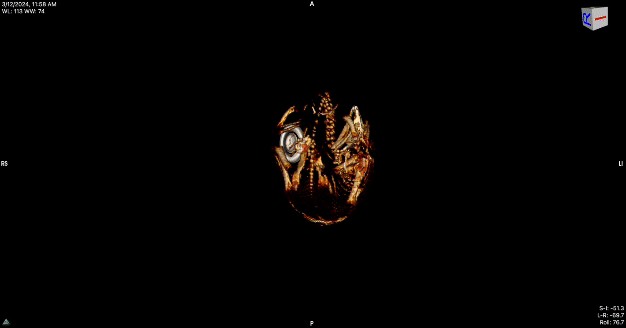Peek Inside a California Condor Egg Just Before It Hatched, With This CT Scan of the Baby Bird
Last month, the San Diego Zoo Wildlife Alliance welcomed its 250th California condor chick in its breeding program, and the CT scan helped determine the bird was well-positioned for hatching

Critically endangered California condors are the largest wild birds soaring through North America’s skies, with wingspans that can top eight feet. But before they can start growing to such large proportions, the creatures must overcome their first hurdle: breaking out of their shells.
A lot can go wrong during hatching, which is why veterinarians who run California condor breeding programs in the United States keep a close eye on developing eggs. Several weeks ago, an egg being monitored by the breeding team at the San Diego Zoo Wildlife Alliance started to raise alarm bells—the chick, it seemed, had gotten into a contorted position.
To assess the situation—and the bird’s survival prospects—specialists placed the California condor egg in a computed tomography (CT) machine, revealing a detailed, three-dimensional view of what was happening inside.
The CT scan—shared last week when the zoo announced the chick had hatched successfully, marking its 250th condor birth—offers a rare glimpse inside the embryonic world of one of the world’s most imperiled birds.
“We can see the skeleton and air pockets in the egg,” says Nora Willis, senior wildlife care specialist for the San Diego Zoo Wildlife Alliance, to New Scientist’s Corryn Wetzel. “I’m still blown away by it.”
For the last four decades, the zoo has been working to bring California condors back from the brink of extinction. Its captive breeding program is one of several across the country that have been instrumental in boosting the species’ numbers. In 1982, just 22 wild condors remained. Today, 344 of the birds are flying freely in the wild, with another 217 living in captivity, according to the latest federal figures. California condors were the first birds to recover from a former “extinct in the wild” status.
Over the winter, two of the zoo’s adult California condors—Xol-Xol (pronounced “hole-hole”) and Mexwe (pronounced “mex-weh”)—successfully mated and laid an egg.
Xol-Xol, the male, was one of the last remaining 22 condors living in the wild in 1982. As a last-ditch attempt to save the species from extinction, wildlife experts captured him and the other free-flying condors, then took them to zoos and conservation facilities.
/https://tf-cmsv2-smithsonianmag-media.s3.amazonaws.com/filer_public/ee/85/ee859a72-617d-4880-bbae-a70e1a4747e6/t2024_0017_wap2401_-_ct_5.jpg)
Xol-Xol—which means “one of the sky people” in the language of the Chumash people—was the first California condor brought under human care for breeding. At the time, he was just three months old and had been abandoned by his parents, reports Popular Science’s Andrew Paul.
Today, he’s 42 years old—and apparently, he’s thriving. Xol-Xol has fathered 41 chicks while living in captivity, many of which have been released into the wild to help the species rebound.
“He’s made incredible contributions,” Willis tells Reuters. “He’s sired so many chicks who are now flying free in the wild, and he’s going to continue to do so, probably for a while.”
His newest progeny hatched in the early morning hours of March 16. Zookeepers named the chick Emaay (pronounced “eh-my”), which means “sky” in the language of the Indigenous Kumeyaay people.
Veterinarians breathed a deep sigh of relief the day tiny Emaay finally hatched. They had ordered Emaay’s CT scan weeks prior, after a regular check-up suggested the bird might be in a “malposition,” which could lower its chance of hatching successfully.
Teams took the egg to the zoo’s in-house Paul Harter Veterinary Medical Center, gently placed it atop a foam block and waited. CT scans use X-rays to capture cross-sectional images, or “slices,” of an object from different angles. Then, a computer program combines the slices into a single, three-dimensional view.
/https://tf-cmsv2-smithsonianmag-media.s3.amazonaws.com/filer_public/8b/5f/8b5f3a24-8869-4a83-9297-6e88f1b4e647/t2024_0017_wap2401_-_ct_4.jpg)
Ultimately, the scan showed that the chick was in a good position inside the egg. Once the chick started “pipping,” the first stage of hatching, the team returned the egg to Xol-Xol and Mexwe. Veterinarians continued to keep a watchful eye on it, however, with the assistance of some infrared cameras pointed at the avian couple’s nest.
Now that the chick has hatched, it’s doing well under the care of its “very attentive parents,” according to the zoo. The baby bird’s sex has not yet been determined.
California condors still face threats, including habitat loss, lead poisoning, litter and emerging diseases, like the deadly avian flu. But wildlife experts are cautiously optimistic about the species’ ongoing recovery. Between 12 and 15 chicks hatch in the wild each year, and several dozen others are born in captivity annually. And many of the captive-born chicks are released into their natural habitat at sites in northern Arizona and California.
If all goes well, Emaay is slated to join the wild population sometime next year. But, in the meantime, zookeepers are still celebrating the chick’s birth.
“Reaching this milestone feels incredible,” says Willis in the statement. “There’s still a long way to go, but being part of this and helping the species recover is life-changing.”
/https://tf-cmsv2-smithsonianmag-media.s3.amazonaws.com/accounts/headshot/SarahKuta.png)
/https://tf-cmsv2-smithsonianmag-media.s3.amazonaws.com/accounts/headshot/SarahKuta.png)